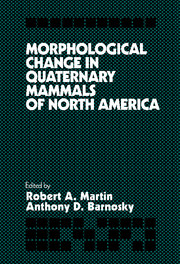Book contents
- Frontmatter
- Contents
- List of Contributors
- Acknowledgments
- 1 Quaternary mammals and evolutionary theory: introductory remarks and historical perspective
- 2 A method for recognizing morphological stasis
- 3 Mosaic evolution at the population level in Microtus pennsylvanicus
- 4 Variogram analysis of paleontological data
- 5 Morphological change in Quaternary mammals: a role for species interactions?
- 6 Rates of evolution in Plio-Pleistocene mammals: six case studies
- 7 Patterns of dental variation and evolution in prairie dogs, genus Cynomys
- 8 Quantitative and qualitative evolution in the giant armadillo Holmesina (Edentata: Pampatheriidae) in Florida
- 9 Evolution of mammoths and moose: the Holarctic perspective
- 10 Evolution of hypsodonty and enamel structure in Plio-Pleistocene rodents
- 11 Patterns of variation and speciation in Quaternary rodents
- 12 Decrease in body size of white-tailed deer (Odocoileus virginianus) during the late Holocene in South Carolina and Georgia
- 13 Short–term fluctuations in small mammals of the late Pleistocene from eastern Washington
- 14 Size change in North American Quaternary jaguars
- 15 Ontogenetic change of Ondatra zibethicus (Arvicolidae, Rodentia) cheek teeth analyzed by digital image processing
- 16 Morphological change in woodrat (Rodentia: Cricetidae) molars
- Index
11 - Patterns of variation and speciation in Quaternary rodents
Published online by Cambridge University Press: 15 December 2009
- Frontmatter
- Contents
- List of Contributors
- Acknowledgments
- 1 Quaternary mammals and evolutionary theory: introductory remarks and historical perspective
- 2 A method for recognizing morphological stasis
- 3 Mosaic evolution at the population level in Microtus pennsylvanicus
- 4 Variogram analysis of paleontological data
- 5 Morphological change in Quaternary mammals: a role for species interactions?
- 6 Rates of evolution in Plio-Pleistocene mammals: six case studies
- 7 Patterns of dental variation and evolution in prairie dogs, genus Cynomys
- 8 Quantitative and qualitative evolution in the giant armadillo Holmesina (Edentata: Pampatheriidae) in Florida
- 9 Evolution of mammoths and moose: the Holarctic perspective
- 10 Evolution of hypsodonty and enamel structure in Plio-Pleistocene rodents
- 11 Patterns of variation and speciation in Quaternary rodents
- 12 Decrease in body size of white-tailed deer (Odocoileus virginianus) during the late Holocene in South Carolina and Georgia
- 13 Short–term fluctuations in small mammals of the late Pleistocene from eastern Washington
- 14 Size change in North American Quaternary jaguars
- 15 Ontogenetic change of Ondatra zibethicus (Arvicolidae, Rodentia) cheek teeth analyzed by digital image processing
- 16 Morphological change in woodrat (Rodentia: Cricetidae) molars
- Index
Summary
The tenth-anniversary issue of Paleobiology (Vol. 11,1985) summarized much of what paleontology has contributed to evolutionary theory and also raised many provocative issues. Gould (1985), for example, proposed that manifestly different evolutionary processes operate at three temporal levels, which he called “tiers.” He defined these tiers as (1) events measured in ecological moments, (2) evolutionary trends over millions of years, and (3) periodic mass extinctions. The theory of punctuated equilibrium was also a dominant theme of Gould's paper, and it remains an important and influential model today, despite Levinton's (1988) articulate criticisms. According to Gould and other proponents of punctuated equilibrium (e.g., Stanley, 1975,1979,1985; Vrba, 1983), microevolution and macroevolution are not necessarily reflections of a single underlying process variously expressed as a function of temporal scale; rather, the two have fundamentally different causative agents. Natural selection, for example, may have a higher-order analogue at the species level (Stanley, 1975; Vrba, 1983). In contrast, Gingerich (1983, 1985) and Levinton (1988) generally support the position that natural selection among individuals and adaptation are the primary driving forces at all hierarchical and temporal levels – the standard Darwinian paradigm. If the process of punctuated equilibrium dominates in the history of life, and if most significant morphological change is concentrated during speciation events, then phyletic change should be, as Stanley (1979) suggests, only the fine-tuning of an organism to its environment.
- Type
- Chapter
- Information
- Morphological Change in Quaternary Mammals of North America , pp. 226 - 280Publisher: Cambridge University PressPrint publication year: 1993
- 19
- Cited by

